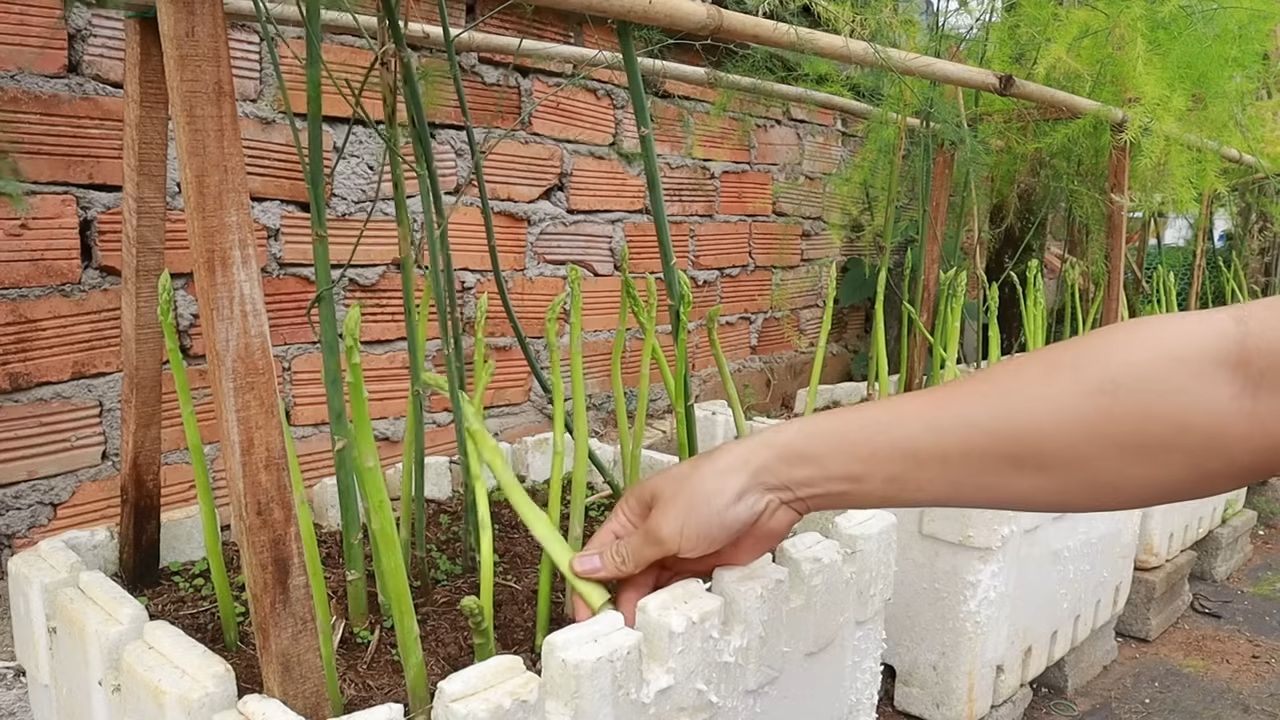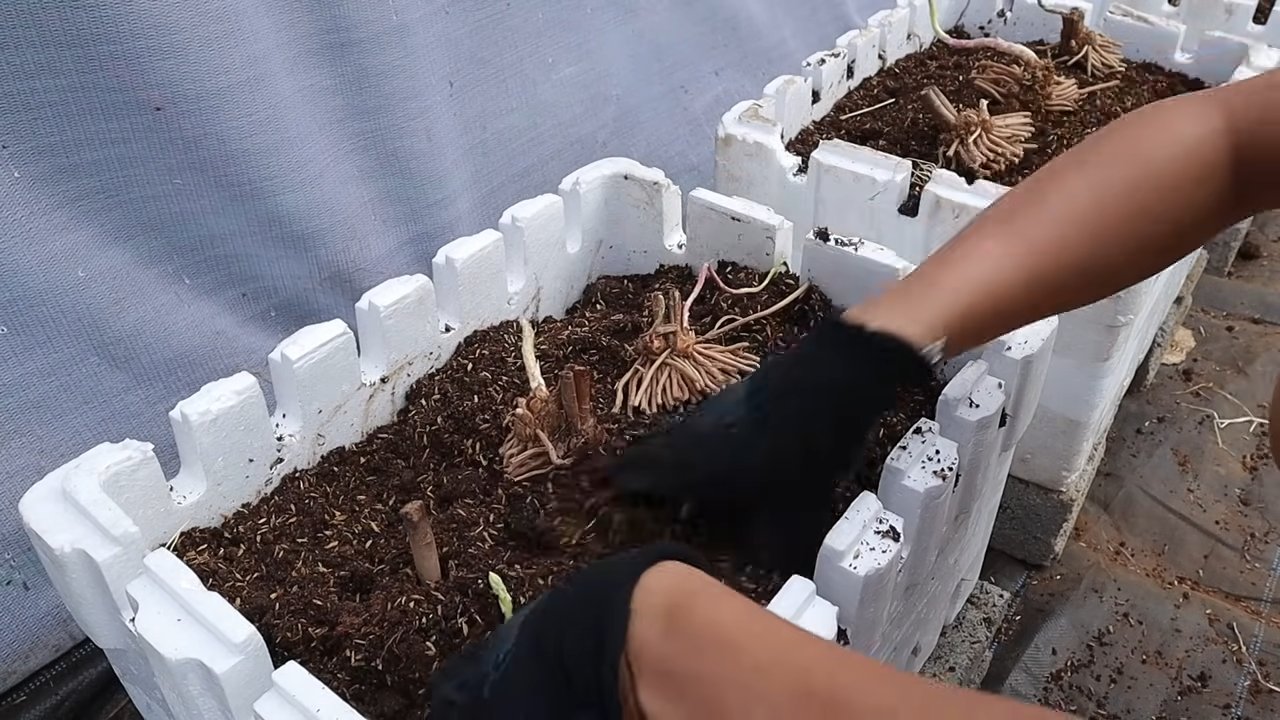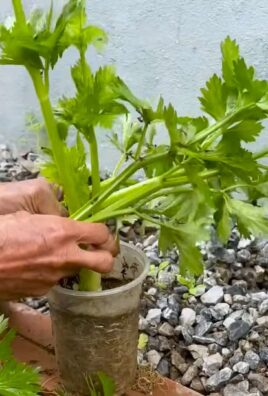Grow Asparagus Fast? Absolutely! Imagine harvesting your own delicious, tender asparagus spears just a few months after planting. Sounds too good to be true? Well, it’s not! For centuries, asparagus has been a prized vegetable, enjoyed by ancient Romans and Greeks for its unique flavor and purported medicinal properties. Today, it’s a springtime delicacy, but often comes with a hefty price tag at the grocery store.
But what if I told you that you could bypass the years-long wait typically associated with growing asparagus? Many gardeners are put off by the conventional wisdom that it takes three years to get a decent harvest. That’s where these DIY tricks and hacks come in! We’re going to explore some proven methods to help you grow asparagus fast and enjoy a bountiful harvest much sooner than you thought possible.
This article is packed with practical tips and step-by-step instructions to accelerate asparagus growth, from selecting the right varieties and preparing your soil to optimizing watering and fertilization. Whether you’re a seasoned gardener or just starting out, these techniques will empower you to cultivate your own thriving asparagus patch and savor the taste of homegrown goodness sooner rather than later. Let’s get started!

Growing Asparagus Faster: A DIY Guide
Asparagus, that delicious and nutritious spring vegetable, is often thought of as a long-term commitment. And it’s true, establishing an asparagus bed takes patience. But what if I told you there are ways to significantly speed up the process and enjoy your own homegrown spears sooner than you think? This guide will walk you through proven techniques to get your asparagus patch producing faster, focusing on variety selection, soil preparation, proper planting, and ongoing care. Let’s get started!
Choosing the Right Asparagus Variety
The first step to faster asparagus harvests is selecting the right variety. Not all asparagus is created equal! Some varieties are bred for faster growth, higher yields, and disease resistance.
* ‘Jersey Knight’: This is a widely recommended male hybrid variety known for its vigor, disease resistance (especially to rust), and early production. Male varieties are generally preferred because they don’t produce seeds, allowing the plant to put more energy into spear production.
* ‘Jersey Giant’: Another excellent male hybrid, ‘Jersey Giant’ is similar to ‘Jersey Knight’ but often produces even larger spears.
* ‘Millennium’: This is a newer hybrid variety that’s gaining popularity for its high yields and excellent spear quality. It’s also known for its tolerance to various soil conditions.
* ‘Apollo’: A reliable and productive variety, ‘Apollo’ is known for its good flavor and disease resistance.
Why Variety Matters: Choosing a variety specifically bred for faster growth and disease resistance will give you a significant head start. Avoid older, open-pollinated varieties, as they tend to be slower to establish and more susceptible to problems.
Preparing the Soil: The Foundation for Success
Asparagus is a heavy feeder and needs well-drained, nutrient-rich soil to thrive. Proper soil preparation is absolutely crucial for fast growth and abundant harvests.
* Soil Testing: Before you do anything, get your soil tested! This will tell you the pH level and nutrient content of your soil. Asparagus prefers a slightly acidic to neutral pH (around 6.5 to 7.0). The test will also indicate any nutrient deficiencies that need to be addressed. You can usually get a soil test done through your local agricultural extension office.
* Amending the Soil: Asparagus needs a lot of organic matter. Amend your soil generously with compost, well-rotted manure, or other organic materials. This will improve drainage, aeration, and water retention, all of which are essential for healthy asparagus growth.
* Adding Nutrients: Based on your soil test results, add any necessary nutrients. Asparagus needs plenty of phosphorus and potassium. Bone meal is an excellent source of phosphorus, and wood ash provides potassium. If your soil is acidic, add lime to raise the pH.
* Creating a Raised Bed (Optional): If your soil is heavy clay or poorly drained, consider creating a raised bed. This will improve drainage and prevent root rot, which can be a major problem for asparagus.
Why Soil Preparation Matters: Asparagus roots can grow deep (up to 6 feet!), so it’s important to create a loose, fertile soil environment that allows them to spread easily and access the nutrients they need.
Planting Asparagus Crowns: The Right Way
Asparagus is typically planted from crowns, which are one-year-old dormant plants. Planting depth and spacing are critical for successful establishment.
* Timing: The best time to plant asparagus crowns is in early spring, as soon as the soil can be worked.
* Trenching: Dig trenches that are about 6-8 inches deep and 12 inches wide. Space the trenches about 4-5 feet apart.
* Mounding: Create a small mound of soil in the bottom of each trench.
* Spacing: Place the asparagus crowns on top of the mounds, spacing them about 12-18 inches apart. Make sure the roots are spread out evenly.
* Covering: Gently cover the crowns with about 2 inches of soil. As the asparagus shoots emerge, gradually fill in the trench with soil until it’s level with the surrounding ground. This process is called “hilling.”
* Watering: Water the newly planted crowns thoroughly.
Why Proper Planting Matters: Planting at the correct depth and spacing allows the asparagus crowns to establish a strong root system and prevents overcrowding. Hilling encourages the development of more spears.
Ongoing Care: Nurturing Your Asparagus Patch
Once your asparagus is planted, it needs consistent care to thrive and produce abundant harvests.
* Watering: Asparagus needs consistent moisture, especially during the growing season. Water deeply and regularly, especially during dry spells.
* Weeding: Keep your asparagus patch free of weeds. Weeds compete with asparagus for nutrients and water. Mulching can help suppress weeds.
* Fertilizing: Fertilize your asparagus patch in early spring and again after the harvest season. Use a balanced fertilizer or side-dress with compost.
* Mulching: Apply a thick layer of mulch around your asparagus plants. This will help retain moisture, suppress weeds, and add organic matter to the soil.
* Pest and Disease Control: Monitor your asparagus plants for pests and diseases. Common pests include asparagus beetles and asparagus aphids. Common diseases include rust and crown rot. Treat any problems promptly with appropriate organic or chemical controls.
Why Ongoing Care Matters: Consistent watering, weeding, fertilizing, and pest/disease control are essential for maintaining a healthy and productive asparagus patch.
Harvesting Asparagus: Patience Pays Off
The most difficult part of growing asparagus is waiting for the first harvest. It’s tempting to start harvesting spears as soon as they emerge, but it’s important to give the plants time to establish a strong root system.
* First Year: Do not harvest any spears in the first year. This allows the plants to focus on root development.
* Second Year: You can harvest a few spears in the second year, but only for a short period (about 2-3 weeks).
* Third Year and Beyond: In the third year and beyond, you can harvest spears for a longer period (about 6-8 weeks).
* Harvesting Technique: Harvest spears when they are about 6-8 inches tall and the tips are still tightly closed. Cut the spears at ground level with a sharp knife.
* Stopping the Harvest: Stop harvesting spears when the spears become thin and spindly. This indicates that the plants are starting to run out of energy.
Why Proper Harvesting Matters: Over-harvesting asparagus can weaken the plants and reduce future yields. Be patient and allow the plants to establish a strong root system before harvesting heavily.
Boosting Growth with Specific Techniques
Beyond the basics, here are some additional techniques I’ve found helpful in accelerating asparagus growth:
* Compost Tea: Regularly watering your asparagus with compost tea provides a readily available source of nutrients and beneficial microbes. I brew my own compost tea using a simple aerator and a bucket of compost.
* Mycorrhizae Inoculation: Mycorrhizae are beneficial fungi that form a symbiotic relationship with plant roots, helping them absorb nutrients and water more efficiently. Inoculating your asparagus roots with mycorrhizae at planting time can give them a significant boost.
* Foliar Feeding: Foliar feeding involves spraying diluted fertilizer directly onto the leaves of the plants. This allows the plants to absorb nutrients quickly and efficiently. I use a diluted seaweed extract for foliar feeding.
* Protecting from Frost: Asparagus spears are susceptible to frost damage. If a late frost is predicted, cover your asparagus plants with blankets or row covers.
* Sunlight: Ensure your asparagus patch receives at least 6-8 hours of direct sunlight per day. Sunlight is essential for photosynthesis and healthy growth.
Overwintering Asparagus: Preparing for the Dormant Season
Preparing your asparagus patch for winter is crucial for ensuring a strong and productive spring.
* Cutting Back Foliage: After the foliage has turned brown and died back in the fall, cut it back to ground level. This will help prevent diseases from overwintering in the foliage.
* Mulching: Apply a thick layer of mulch around your asparagus plants to protect the crowns from freezing temperatures. I use straw or shredded leaves for mulching.
* Adding Compost: Spread a layer of compost around your asparagus plants in the fall. This will provide nutrients for the plants to use in the spring.
* Checking for Pests and Diseases: Before winter sets in, inspect your asparagus plants for any signs of pests or diseases. Treat any problems promptly to prevent them from spreading.
By following these steps, you can significantly speed up the process of growing asparagus and enjoy your own homegrown spears much sooner than you might think. Remember, patience and consistent care are key to success. Happy gardening!

Conclusion
So, there you have it! Mastering the art of how to grow asparagus fast is not only achievable but also incredibly rewarding. We’ve explored proven techniques, from strategic soil preparation and selecting the right crowns to providing optimal watering and fertilization. By implementing these methods, you’re setting the stage for a bountiful asparagus harvest much sooner than you might have thought possible.
But why is this DIY trick a must-try? Beyond the obvious benefit of enjoying fresh, homegrown asparagus, consider the satisfaction of nurturing your own food source. Asparagus, with its delicate flavor and nutritional powerhouse, is a culinary gem that elevates any meal. Growing it yourself ensures you have access to the freshest, most flavorful spears, free from the chemicals and long-distance transportation often associated with store-bought produce. Plus, asparagus is a perennial, meaning once established, your patch will provide you with delicious spears for years to come!
Don’t be afraid to experiment and personalize your approach. For instance, if you live in a region with particularly harsh winters, consider adding an extra layer of mulch for added protection. If your soil is naturally acidic, incorporate lime to raise the pH to the ideal range for asparagus. You can also explore different asparagus varieties to find the ones that thrive best in your specific climate and soil conditions. Jersey Knight and Mary Washington are popular choices, but there are many others to discover.
Another exciting variation is to try growing asparagus in raised beds or containers. This is a great option if you have limited space or poor soil quality. Just be sure to choose a container that is large enough to accommodate the asparagus roots, and use a well-draining potting mix.
The key to success is consistency and observation. Regularly monitor your asparagus patch for signs of pests or diseases, and address any issues promptly. Pay attention to the plant’s growth and adjust your watering and fertilization accordingly. Remember, every garden is unique, and what works for one person may not work for another.
We wholeheartedly encourage you to embark on this exciting gardening adventure. Growing your own asparagus is a fulfilling experience that connects you with nature and provides you with a delicious and healthy food source. Don’t be intimidated by the perceived challenges – with a little knowledge and effort, you can successfully grow asparagus fast and enjoy the fruits (or rather, spears) of your labor.
Once you’ve tried these techniques, we’d love to hear about your experience! Share your successes, challenges, and any tips you’ve discovered along the way in the comments section below. Your insights can help other aspiring asparagus growers achieve their gardening goals. Let’s create a community of passionate gardeners who are dedicated to growing the best asparagus possible! Happy gardening!
Frequently Asked Questions (FAQ)
How long does it really take to grow asparagus from seed versus crowns?
Growing asparagus from seed is a much longer process than starting with crowns. From seed, it can take 2-3 years before you can harvest any spears. This is because the plants need time to develop a strong root system. Crowns, on the other hand, are already established plants, so you can typically harvest a small crop in the second year after planting. While starting from seed is more economical, crowns offer a significant time advantage for those eager to enjoy homegrown asparagus sooner.
What kind of soil is best for growing asparagus?
Asparagus thrives in well-drained, sandy loam soil that is rich in organic matter. The soil should have a pH between 6.5 and 7.5. Good drainage is crucial because asparagus roots are susceptible to rot if they sit in waterlogged soil. Before planting, amend the soil with plenty of compost or well-rotted manure to improve its fertility and drainage. If your soil is heavy clay, consider adding sand or perlite to improve its texture.
How often should I water my asparagus plants?
Asparagus needs consistent moisture, especially during the growing season. Water deeply whenever the top inch of soil feels dry. Avoid overwatering, as this can lead to root rot. During dry spells, you may need to water more frequently. Mulching around the plants can help retain moisture and reduce the need for frequent watering. In the fall, reduce watering as the plants prepare for dormancy.
What kind of fertilizer should I use for asparagus?
Asparagus benefits from regular fertilization. In the spring, apply a balanced fertilizer, such as 10-10-10, to provide the plants with essential nutrients. You can also use a fertilizer specifically formulated for vegetables. Side-dress the plants with compost or well-rotted manure throughout the growing season to provide a slow-release source of nutrients. Avoid over-fertilizing, as this can lead to excessive foliage growth at the expense of spear production.
How do I know when to harvest asparagus?
Asparagus spears are ready to harvest when they are about 6-8 inches tall and the tips are still tightly closed. Use a sharp knife to cut the spears at ground level. Avoid cutting spears that are too thin, as these will not be as flavorful. In the first year after planting crowns, refrain from harvesting any spears to allow the plants to establish themselves. In the second year, you can harvest for a short period (about 2-3 weeks). In subsequent years, you can harvest for a longer period (6-8 weeks). Stop harvesting when the spears become thin and spindly, as this indicates that the plants need to replenish their energy reserves.
What are some common pests and diseases that affect asparagus?
Asparagus beetles are a common pest that can damage asparagus spears and foliage. Handpicking the beetles or using insecticidal soap can help control infestations. Asparagus rust is a fungal disease that can cause orange pustules on the foliage. Planting rust-resistant varieties and ensuring good air circulation can help prevent rust. Crown rot is another fungal disease that can affect asparagus, particularly in poorly drained soil. Improving drainage and avoiding overwatering can help prevent crown rot.
Can I grow asparagus in containers?
Yes, you can grow asparagus in containers, but you’ll need to choose a large container (at least 18 inches in diameter and depth) to accommodate the asparagus roots. Use a well-draining potting mix and provide regular watering and fertilization. Container-grown asparagus may require more frequent watering than asparagus grown in the ground. Be sure to choose a sunny location for your container asparagus.
How do I prepare my asparagus bed for winter?
In the fall, after the foliage has turned yellow and died back, cut it down to ground level. Remove any debris from the asparagus bed to prevent the spread of diseases. Apply a layer of mulch, such as straw or leaves, to protect the crowns from freezing temperatures. In colder climates, you may need to provide additional winter protection, such as covering the bed with a tarp or blanket.
Is it possible to grow asparagus in warmer climates?
Yes, it is possible to grow asparagus in warmer climates, but you’ll need to choose varieties that are adapted to warmer temperatures. Jersey Knight and UC 157 are two varieties that are known to perform well in warmer climates. Provide adequate shade during the hottest part of the day and ensure that the soil is well-drained to prevent root rot.
How can I encourage thicker asparagus spears?
To encourage thicker asparagus spears, ensure that your plants are receiving adequate sunlight, water, and nutrients. Avoid over-harvesting, as this can weaken the plants and lead to thinner spears. Allow the plants to fully mature before harvesting, and stop harvesting when the spears become thin and spindly. Adding compost or well-rotted manure to the soil can also help improve spear thickness.




Leave a Comment